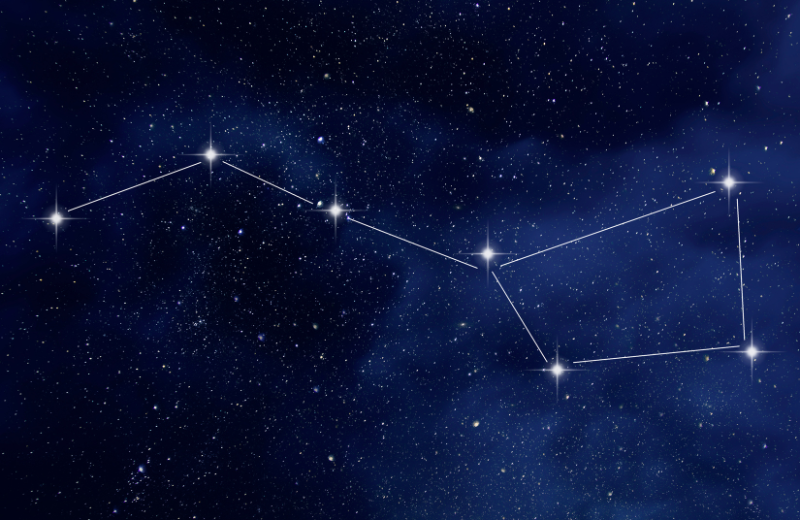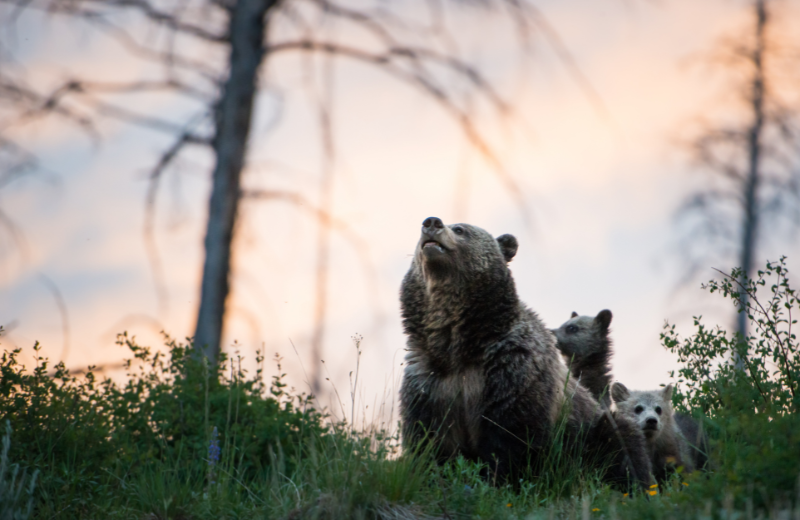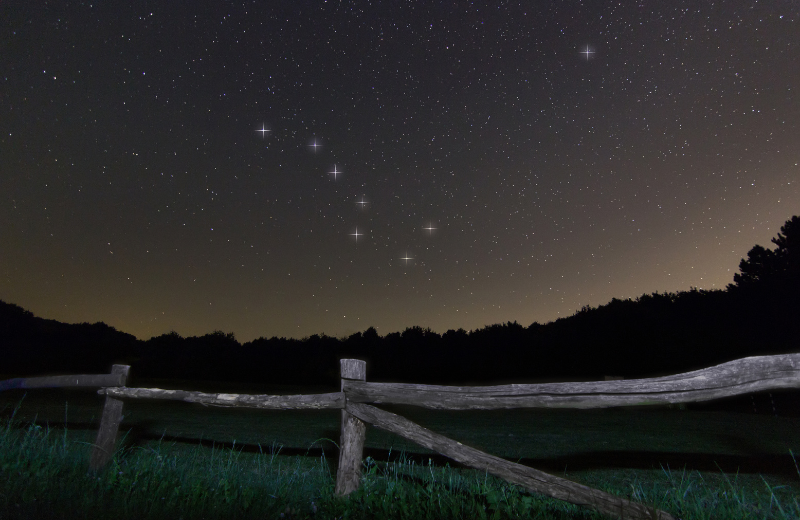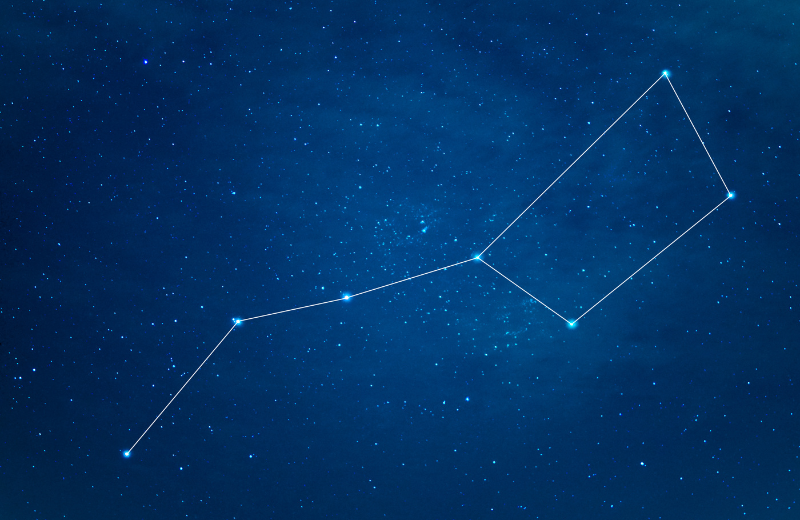The night sky is a source of wonder and curiosity, filled with countless stars that have captivated humans for millennia. Among these celestial patterns, Ursa Major, known as The Great Bear, is one of the most famous and recognisable constellations. Whether you're new to stargazing or a seasoned observer, learning about Ursa Major can enrich your experience and understanding of the night sky. In this guide, we’ll explore everything you need to know about this fascinating constellation.
Jump to:
- What is the Ursa Major Constellation?
- What Does Ursa Major Look Like?
- The Ursa Major Constellation Myth
- What Does the Ursa Major Constellation Symbolise?
- What Galaxy is Ursa Major In?
- How to Pronounce Ursa Major
- Ursa Major's Stars
- Nebulae in Ursa Major Constellation
- Finding Ursa Major in the Sky
- Fun Facts About Ursa Major
- Study Astronomy for £29
Recommended for you!
Best SellersWhat is the Ursa Major Constellation?
Ursa Major, Latin for "Great Bear," is a prominent constellation in the northern sky. It's one of the largest and most well-known constellations, visible throughout the year in most of the northern hemisphere. But why is Ursa Major so famous? One reason is that it contains the Big Dipper, an asterism (a recognisable pattern of stars) that has been used for navigation and timekeeping for centuries.
The constellation has been known since ancient times and appears in the folklore and mythology of many cultures. In Greek mythology, it represents a bear, and this imagery has persisted across various civilisations, leading to its name, The Great Bear.
What Does Ursa Major Look Like?

Ursa Major is most easily recognised by the Big Dipper, which forms the bear's tail and hindquarters. The Big Dipper consists of seven bright stars: Alkaid, Mizar, Alioth, Megrez, Phecda, Dubhe, and Merak. These stars are relatively close together and form a shape that resembles a ladle or dipper, hence the name.
However, the Big Dipper is just a part of Ursa Major. The constellation extends beyond these seven stars, with additional stars forming the bear's body, head, and legs. The full constellation is much larger than the Big Dipper, but the additional stars are fainter and require a darker sky to see clearly.
The Ursa Major Constellation Myth
The mythology of Ursa Major is rich and varied, with different stories depending on the culture. The most famous myth comes from Greek mythology, where Ursa Major is linked to the story of Callisto, a nymph who was transformed into a bear by the jealous goddess Hera. After being turned into a bear, Callisto was placed in the sky by Zeus to protect her from further harm, where she became the constellation Ursa Major.
This myth is mirrored in many cultures, each with its own interpretation. In Native American tradition, the constellation often represents a bear being hunted by a group of warriors. In Hindu mythology, the seven stars of the Big Dipper are seen as the "Saptarishi," or seven great sages.
What Does the Ursa Major Constellation Symbolise?

Ursa Major has long been a symbol of strength and endurance, largely due to its association with the mighty bear. In many cultures, the bear is a powerful animal, often linked to survival and resilience. As a constellation, Ursa Major symbolises these qualities, serving as a celestial reminder of the bear’s significance in mythology and nature.
The constellation also holds a practical significance. Because it is visible year-round in the northern hemisphere, it has been a dependable guide for navigation. Its position in the sky changes with the seasons, helping ancient peoples to track time and navigate across vast distances.
What Galaxy is Ursa Major In?
Ursa Major is part of the Milky Way galaxy, the same galaxy that contains our solar system. Within Ursa Major, however, are several notable galaxies that can be observed with a telescope. One of the most famous is the Pinwheel Galaxy (M101), a stunning spiral galaxy located near the star Alkaid, the tip of the Big Dipper’s handle.
Another interesting galaxy within Ursa Major is M81, also known as Bode's Galaxy, which is a bright spiral galaxy located near the star Dubhe. These galaxies are part of a larger group known as the M81 Group, which is one of the closest groups of galaxies to our own Local Group.
How to Pronounce Ursa Major
The name "Ursa Major" is pronounced as Ur-suh May-jur. The word "Ursa" comes from Latin, meaning "bear," and "Major" means "greater" or "larger." Together, they translate to "Great Bear." It’s a name that’s as grand as the constellation itself, reflecting its importance and prominence in the night sky.
Ursa Major's Stars

The stars of Ursa Major are a diverse and fascinating group. While the Big Dipper’s seven stars are the most well-known, they are just part of the constellation’s broader star field.
What are the 7 Stars in Ursa Major?
The seven stars that form the Big Dipper, which is part of Ursa Major, are:
- Alkaid - The star at the end of the Big Dipper's handle.
- Mizar - The second star in the handle, famous for its nearby companion star, Alcor.
- Alioth - The brightest star in the handle of the Big Dipper.
- Megrez - The star connecting the handle to the bowl.
- Phecda - The star forming the bottom left of the bowl.
- Dubhe - The top right star of the bowl, one of the pointer stars.
- Merak - The bottom right star of the bowl, the other pointer star.
These stars have been used for centuries to navigate and locate other stars, particularly Polaris, the North Star.
Nebulae in Ursa Major Constellation
Ursa Major is also home to some fascinating nebulae. One of the most notable is the Owl Nebula (M97), a planetary nebula located near the bottom of the bear's body. This nebula is visible with a moderate telescope and is named for its resemblance to an owl’s face when viewed through a telescope.
These nebulae add to the rich tapestry of objects within Ursa Major, making it a treasure trove for astronomers and stargazers alike.
Finding Ursa Major in the Sky

Ursa Major is one of the most recognisable constellations in the northern hemisphere, and it’s visible throughout the year. Its most famous feature, the Big Dipper, serves as a key to locating the entire constellation. Whether you’re using the naked eye, binoculars, or a telescope, here’s how you can find Ursa Major and explore its celestial wonders.
Locating the Big Dipper
The Big Dipper is the easiest part of Ursa Major to spot, making it a great starting point for locating the rest of the constellation. To find the Big Dipper, look towards the northern sky on a clear night. The Big Dipper consists of seven bright stars that form a distinctive ladle or dipper shape. It’s often found high in the sky during spring and summer evenings, but it’s visible all year round in most of the northern hemisphere.
Once you’ve identified the Big Dipper, you can use it to trace out the rest of Ursa Major. The stars of the Big Dipper form the bear’s tail and hindquarters, while the other stars of Ursa Major extend out to form the bear’s head, legs, and body.
Viewing Ursa Major with Binoculars or a Telescope
While the Big Dipper and other main stars of Ursa Major can be easily seen with the naked eye, binoculars or a small telescope can enhance your viewing experience by revealing more stars and deep-sky objects within the constellation.
- With Binoculars: Binoculars will allow you to see more of the fainter stars that make up the rest of Ursa Major, helping you to trace out the full shape of the bear. You can also spot some of the double stars within the constellation, such as Mizar and Alcor in the Big Dipper’s handle.
- With a Telescope: A small to medium telescope can reveal even more of Ursa Major’s treasures. You’ll be able to observe the famous double star Mizar and Alcor in greater detail, as well as other deep-sky objects like the Owl Nebula (M97) and the Pinwheel Galaxy (M101).
Using the Big Dipper for Navigation
The Big Dipper is a practical tool for navigation. The two stars at the end of the Big Dipper’s bowl, Dubhe and Merak, are known as the "pointer stars." By drawing a line through these stars, you can locate Polaris, the North Star, which is part of the constellation Ursa Minor.
Polaris is an important star for navigation because it remains almost fixed in the sky, marking true north. This makes the Big Dipper an invaluable guide for travellers and stargazers.
Special Features to Observe
Ursa Major is home to several interesting features that make it a rewarding constellation to explore:
- The Owl Nebula (M97): A planetary nebula located near the bottom of the bear's body, it appears as a faint, round, smoky shape through a telescope.
- The Pinwheel Galaxy (M101): This spiral galaxy is located near the star Alkaid at the tip of the Big Dipper’s handle and is a stunning sight through a telescope.
The Best Viewing Times
Ursa Major is visible throughout the year in the northern hemisphere, but it’s particularly prominent during the spring and early summer months. For the best viewing experience, find a dark location away from city lights and allow your eyes to adjust to the darkness. This will help you to see the fainter stars that make up the full constellation and its surrounding deep-sky objects.
Fun Facts About Ursa Major
Here are some fun facts about Ursa Major that you might not know:
- Ursa Major is the third largest constellation in the sky. It covers an area of 1,280 square degrees, making it one of the most expansive constellations.
- The Big Dipper is visible year-round in most of the northern hemisphere, making it one of the most recognisable star patterns in the sky.
- Ursa Major is home to several famous galaxies, including the Pinwheel Galaxy (M101) and Bode’s Galaxy (M81). These galaxies are part of the M81 Group, which is relatively close to our own Milky Way galaxy.
- The constellation has been known since ancient times and appears in the mythologies of many cultures, from Greek to Native American traditions.
- The stars of the Big Dipper are not all the same age or distance from Earth. For example, Mizar and Alcor are a famous double star system, where the two stars are physically close to each other.
Recommended for you!
Best SellersStudy Astronomy for £29
If you’re fascinated by the stars and want to learn more about the universe, consider enrolling in our Astronomy Diploma Course at Centre of Excellence. You’ll gain a detailed understanding of the stars, planets, and celestial phenomena, all from the comfort of your own home. Sign up today for a discounted price of £29 and start your journey into the cosmos!













